Policy Framework: Addressing Violence Against Women in the US
VerifiedAdded on 2023/06/10
|9
|3167
|281
Report
AI Summary
This report presents a policy proposal addressing the pervasive issue of violence against women in the United States. It begins by outlining the scope of the problem, including intimate partner violence and sexual assault, supported by statistical data. The report then evaluates the policy development cycle, emphasizing the influence of stakeholders, including individual advocates and institutions, on the policy-making process. It discusses how these factors can drive social change by incorporating public opinion and victim perspectives. The role of human service professionals in policy advocacy is highlighted, along with essential resources such as the Violence Against Women Act and the Family Violence Prevention and Services Act. Finally, the report identifies key steps for policy implementation and criteria for measuring policy effectiveness. Desklib offers a wealth of similar documents and study tools for students.
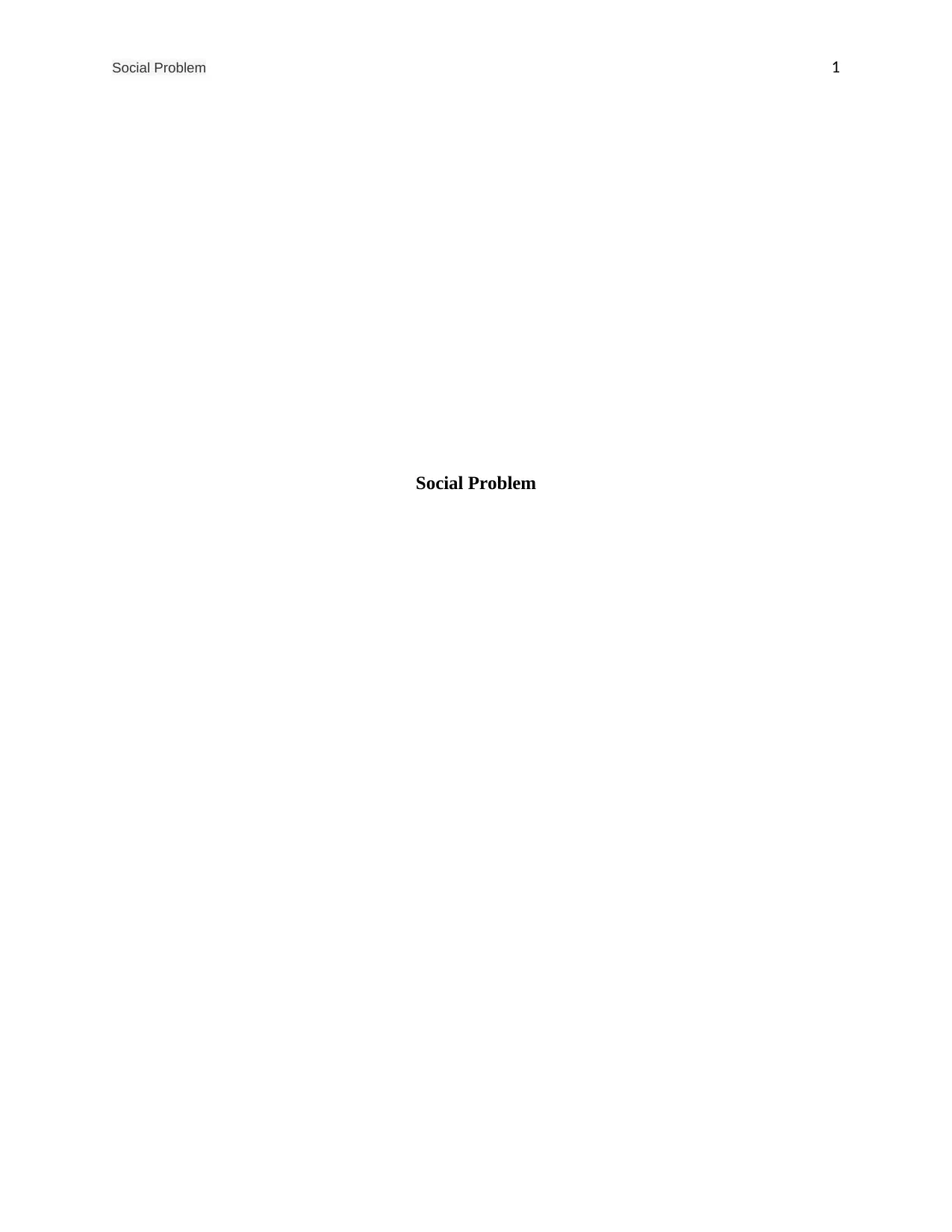
Social Problem 1
Social Problem
Social Problem
Paraphrase This Document
Need a fresh take? Get an instant paraphrase of this document with our AI Paraphraser
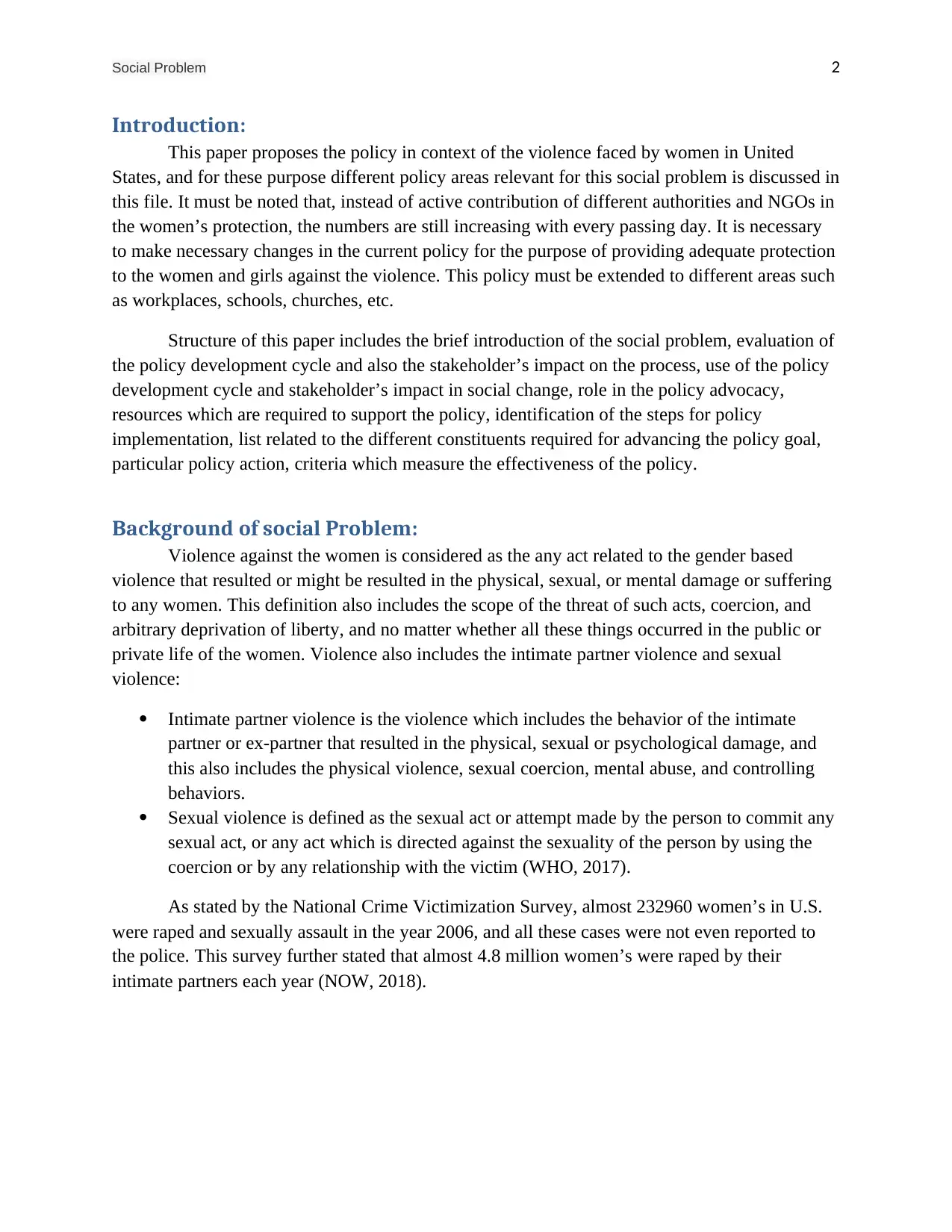
Social Problem 2
Introduction:
This paper proposes the policy in context of the violence faced by women in United
States, and for these purpose different policy areas relevant for this social problem is discussed in
this file. It must be noted that, instead of active contribution of different authorities and NGOs in
the women’s protection, the numbers are still increasing with every passing day. It is necessary
to make necessary changes in the current policy for the purpose of providing adequate protection
to the women and girls against the violence. This policy must be extended to different areas such
as workplaces, schools, churches, etc.
Structure of this paper includes the brief introduction of the social problem, evaluation of
the policy development cycle and also the stakeholder’s impact on the process, use of the policy
development cycle and stakeholder’s impact in social change, role in the policy advocacy,
resources which are required to support the policy, identification of the steps for policy
implementation, list related to the different constituents required for advancing the policy goal,
particular policy action, criteria which measure the effectiveness of the policy.
Background of social Problem:
Violence against the women is considered as the any act related to the gender based
violence that resulted or might be resulted in the physical, sexual, or mental damage or suffering
to any women. This definition also includes the scope of the threat of such acts, coercion, and
arbitrary deprivation of liberty, and no matter whether all these things occurred in the public or
private life of the women. Violence also includes the intimate partner violence and sexual
violence:
Intimate partner violence is the violence which includes the behavior of the intimate
partner or ex-partner that resulted in the physical, sexual or psychological damage, and
this also includes the physical violence, sexual coercion, mental abuse, and controlling
behaviors.
Sexual violence is defined as the sexual act or attempt made by the person to commit any
sexual act, or any act which is directed against the sexuality of the person by using the
coercion or by any relationship with the victim (WHO, 2017).
As stated by the National Crime Victimization Survey, almost 232960 women’s in U.S.
were raped and sexually assault in the year 2006, and all these cases were not even reported to
the police. This survey further stated that almost 4.8 million women’s were raped by their
intimate partners each year (NOW, 2018).
Introduction:
This paper proposes the policy in context of the violence faced by women in United
States, and for these purpose different policy areas relevant for this social problem is discussed in
this file. It must be noted that, instead of active contribution of different authorities and NGOs in
the women’s protection, the numbers are still increasing with every passing day. It is necessary
to make necessary changes in the current policy for the purpose of providing adequate protection
to the women and girls against the violence. This policy must be extended to different areas such
as workplaces, schools, churches, etc.
Structure of this paper includes the brief introduction of the social problem, evaluation of
the policy development cycle and also the stakeholder’s impact on the process, use of the policy
development cycle and stakeholder’s impact in social change, role in the policy advocacy,
resources which are required to support the policy, identification of the steps for policy
implementation, list related to the different constituents required for advancing the policy goal,
particular policy action, criteria which measure the effectiveness of the policy.
Background of social Problem:
Violence against the women is considered as the any act related to the gender based
violence that resulted or might be resulted in the physical, sexual, or mental damage or suffering
to any women. This definition also includes the scope of the threat of such acts, coercion, and
arbitrary deprivation of liberty, and no matter whether all these things occurred in the public or
private life of the women. Violence also includes the intimate partner violence and sexual
violence:
Intimate partner violence is the violence which includes the behavior of the intimate
partner or ex-partner that resulted in the physical, sexual or psychological damage, and
this also includes the physical violence, sexual coercion, mental abuse, and controlling
behaviors.
Sexual violence is defined as the sexual act or attempt made by the person to commit any
sexual act, or any act which is directed against the sexuality of the person by using the
coercion or by any relationship with the victim (WHO, 2017).
As stated by the National Crime Victimization Survey, almost 232960 women’s in U.S.
were raped and sexually assault in the year 2006, and all these cases were not even reported to
the police. This survey further stated that almost 4.8 million women’s were raped by their
intimate partners each year (NOW, 2018).
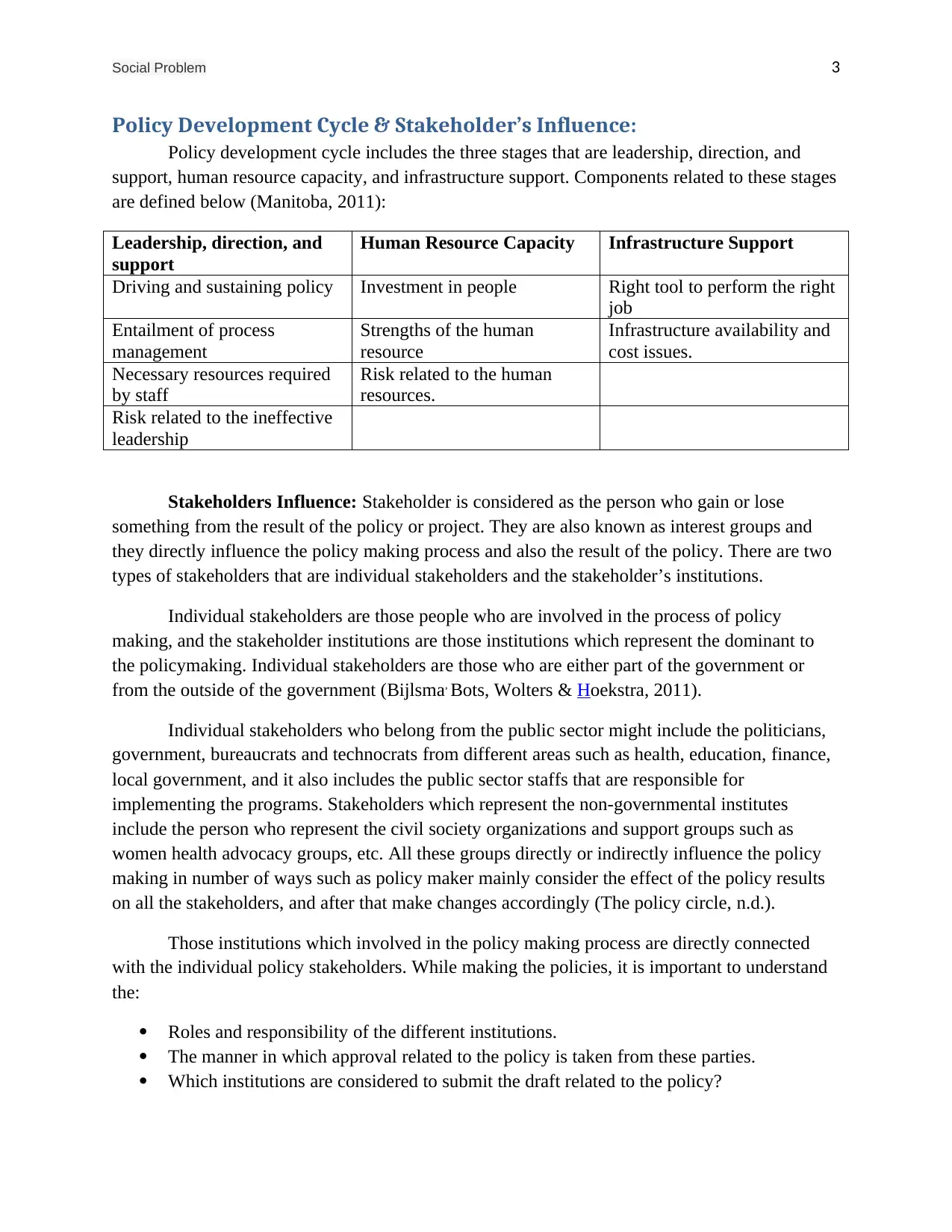
Social Problem 3
Policy Development Cycle & Stakeholder’s Influence:
Policy development cycle includes the three stages that are leadership, direction, and
support, human resource capacity, and infrastructure support. Components related to these stages
are defined below (Manitoba, 2011):
Leadership, direction, and
support
Human Resource Capacity Infrastructure Support
Driving and sustaining policy Investment in people Right tool to perform the right
job
Entailment of process
management
Strengths of the human
resource
Infrastructure availability and
cost issues.
Necessary resources required
by staff
Risk related to the human
resources.
Risk related to the ineffective
leadership
Stakeholders Influence: Stakeholder is considered as the person who gain or lose
something from the result of the policy or project. They are also known as interest groups and
they directly influence the policy making process and also the result of the policy. There are two
types of stakeholders that are individual stakeholders and the stakeholder’s institutions.
Individual stakeholders are those people who are involved in the process of policy
making, and the stakeholder institutions are those institutions which represent the dominant to
the policymaking. Individual stakeholders are those who are either part of the government or
from the outside of the government (Bijlsma, Bots, Wolters & Hoekstra, 2011).
Individual stakeholders who belong from the public sector might include the politicians,
government, bureaucrats and technocrats from different areas such as health, education, finance,
local government, and it also includes the public sector staffs that are responsible for
implementing the programs. Stakeholders which represent the non-governmental institutes
include the person who represent the civil society organizations and support groups such as
women health advocacy groups, etc. All these groups directly or indirectly influence the policy
making in number of ways such as policy maker mainly consider the effect of the policy results
on all the stakeholders, and after that make changes accordingly (The policy circle, n.d.).
Those institutions which involved in the policy making process are directly connected
with the individual policy stakeholders. While making the policies, it is important to understand
the:
Roles and responsibility of the different institutions.
The manner in which approval related to the policy is taken from these parties.
Which institutions are considered to submit the draft related to the policy?
Policy Development Cycle & Stakeholder’s Influence:
Policy development cycle includes the three stages that are leadership, direction, and
support, human resource capacity, and infrastructure support. Components related to these stages
are defined below (Manitoba, 2011):
Leadership, direction, and
support
Human Resource Capacity Infrastructure Support
Driving and sustaining policy Investment in people Right tool to perform the right
job
Entailment of process
management
Strengths of the human
resource
Infrastructure availability and
cost issues.
Necessary resources required
by staff
Risk related to the human
resources.
Risk related to the ineffective
leadership
Stakeholders Influence: Stakeholder is considered as the person who gain or lose
something from the result of the policy or project. They are also known as interest groups and
they directly influence the policy making process and also the result of the policy. There are two
types of stakeholders that are individual stakeholders and the stakeholder’s institutions.
Individual stakeholders are those people who are involved in the process of policy
making, and the stakeholder institutions are those institutions which represent the dominant to
the policymaking. Individual stakeholders are those who are either part of the government or
from the outside of the government (Bijlsma, Bots, Wolters & Hoekstra, 2011).
Individual stakeholders who belong from the public sector might include the politicians,
government, bureaucrats and technocrats from different areas such as health, education, finance,
local government, and it also includes the public sector staffs that are responsible for
implementing the programs. Stakeholders which represent the non-governmental institutes
include the person who represent the civil society organizations and support groups such as
women health advocacy groups, etc. All these groups directly or indirectly influence the policy
making in number of ways such as policy maker mainly consider the effect of the policy results
on all the stakeholders, and after that make changes accordingly (The policy circle, n.d.).
Those institutions which involved in the policy making process are directly connected
with the individual policy stakeholders. While making the policies, it is important to understand
the:
Roles and responsibility of the different institutions.
The manner in which approval related to the policy is taken from these parties.
Which institutions are considered to submit the draft related to the policy?
⊘ This is a preview!⊘
Do you want full access?
Subscribe today to unlock all pages.

Trusted by 1+ million students worldwide
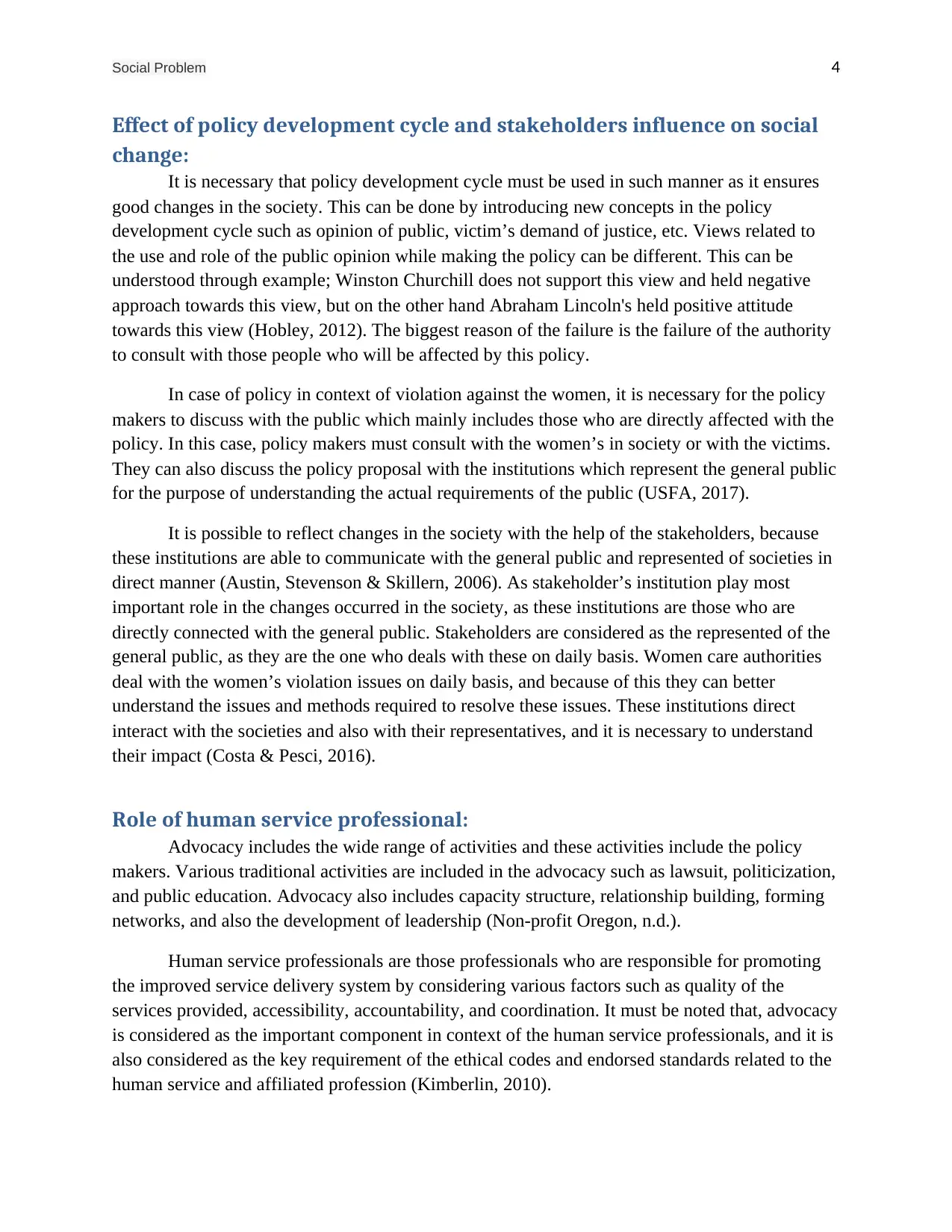
Social Problem 4
Effect of policy development cycle and stakeholders influence on social
change:
It is necessary that policy development cycle must be used in such manner as it ensures
good changes in the society. This can be done by introducing new concepts in the policy
development cycle such as opinion of public, victim’s demand of justice, etc. Views related to
the use and role of the public opinion while making the policy can be different. This can be
understood through example; Winston Churchill does not support this view and held negative
approach towards this view, but on the other hand Abraham Lincoln's held positive attitude
towards this view (Hobley, 2012). The biggest reason of the failure is the failure of the authority
to consult with those people who will be affected by this policy.
In case of policy in context of violation against the women, it is necessary for the policy
makers to discuss with the public which mainly includes those who are directly affected with the
policy. In this case, policy makers must consult with the women’s in society or with the victims.
They can also discuss the policy proposal with the institutions which represent the general public
for the purpose of understanding the actual requirements of the public (USFA, 2017).
It is possible to reflect changes in the society with the help of the stakeholders, because
these institutions are able to communicate with the general public and represented of societies in
direct manner (Austin, Stevenson & Skillern, 2006). As stakeholder’s institution play most
important role in the changes occurred in the society, as these institutions are those who are
directly connected with the general public. Stakeholders are considered as the represented of the
general public, as they are the one who deals with these on daily basis. Women care authorities
deal with the women’s violation issues on daily basis, and because of this they can better
understand the issues and methods required to resolve these issues. These institutions direct
interact with the societies and also with their representatives, and it is necessary to understand
their impact (Costa & Pesci, 2016).
Role of human service professional:
Advocacy includes the wide range of activities and these activities include the policy
makers. Various traditional activities are included in the advocacy such as lawsuit, politicization,
and public education. Advocacy also includes capacity structure, relationship building, forming
networks, and also the development of leadership (Non-profit Oregon, n.d.).
Human service professionals are those professionals who are responsible for promoting
the improved service delivery system by considering various factors such as quality of the
services provided, accessibility, accountability, and coordination. It must be noted that, advocacy
is considered as the important component in context of the human service professionals, and it is
also considered as the key requirement of the ethical codes and endorsed standards related to the
human service and affiliated profession (Kimberlin, 2010).
Effect of policy development cycle and stakeholders influence on social
change:
It is necessary that policy development cycle must be used in such manner as it ensures
good changes in the society. This can be done by introducing new concepts in the policy
development cycle such as opinion of public, victim’s demand of justice, etc. Views related to
the use and role of the public opinion while making the policy can be different. This can be
understood through example; Winston Churchill does not support this view and held negative
approach towards this view, but on the other hand Abraham Lincoln's held positive attitude
towards this view (Hobley, 2012). The biggest reason of the failure is the failure of the authority
to consult with those people who will be affected by this policy.
In case of policy in context of violation against the women, it is necessary for the policy
makers to discuss with the public which mainly includes those who are directly affected with the
policy. In this case, policy makers must consult with the women’s in society or with the victims.
They can also discuss the policy proposal with the institutions which represent the general public
for the purpose of understanding the actual requirements of the public (USFA, 2017).
It is possible to reflect changes in the society with the help of the stakeholders, because
these institutions are able to communicate with the general public and represented of societies in
direct manner (Austin, Stevenson & Skillern, 2006). As stakeholder’s institution play most
important role in the changes occurred in the society, as these institutions are those who are
directly connected with the general public. Stakeholders are considered as the represented of the
general public, as they are the one who deals with these on daily basis. Women care authorities
deal with the women’s violation issues on daily basis, and because of this they can better
understand the issues and methods required to resolve these issues. These institutions direct
interact with the societies and also with their representatives, and it is necessary to understand
their impact (Costa & Pesci, 2016).
Role of human service professional:
Advocacy includes the wide range of activities and these activities include the policy
makers. Various traditional activities are included in the advocacy such as lawsuit, politicization,
and public education. Advocacy also includes capacity structure, relationship building, forming
networks, and also the development of leadership (Non-profit Oregon, n.d.).
Human service professionals are those professionals who are responsible for promoting
the improved service delivery system by considering various factors such as quality of the
services provided, accessibility, accountability, and coordination. It must be noted that, advocacy
is considered as the important component in context of the human service professionals, and it is
also considered as the key requirement of the ethical codes and endorsed standards related to the
human service and affiliated profession (Kimberlin, 2010).
Paraphrase This Document
Need a fresh take? Get an instant paraphrase of this document with our AI Paraphraser
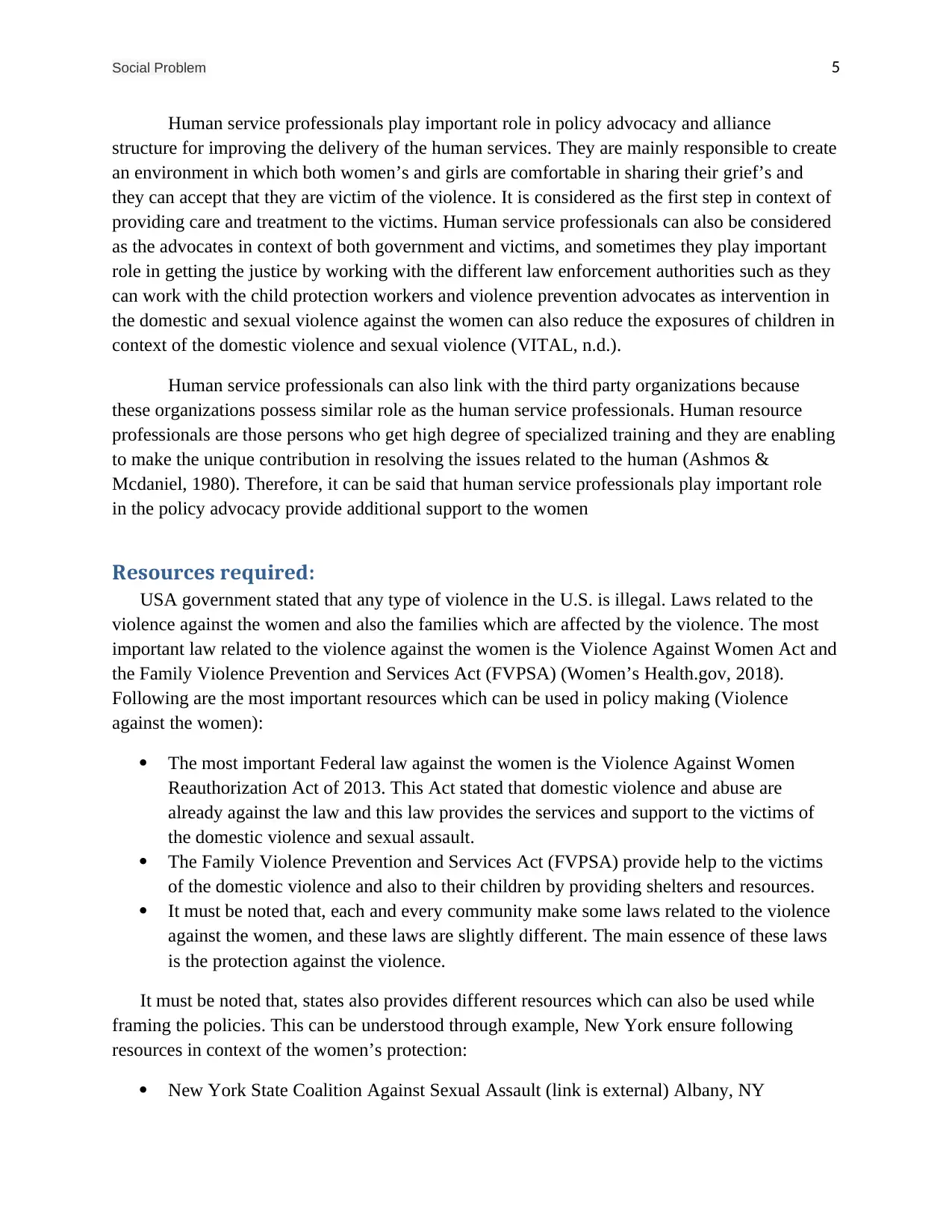
Social Problem 5
Human service professionals play important role in policy advocacy and alliance
structure for improving the delivery of the human services. They are mainly responsible to create
an environment in which both women’s and girls are comfortable in sharing their grief’s and
they can accept that they are victim of the violence. It is considered as the first step in context of
providing care and treatment to the victims. Human service professionals can also be considered
as the advocates in context of both government and victims, and sometimes they play important
role in getting the justice by working with the different law enforcement authorities such as they
can work with the child protection workers and violence prevention advocates as intervention in
the domestic and sexual violence against the women can also reduce the exposures of children in
context of the domestic violence and sexual violence (VITAL, n.d.).
Human service professionals can also link with the third party organizations because
these organizations possess similar role as the human service professionals. Human resource
professionals are those persons who get high degree of specialized training and they are enabling
to make the unique contribution in resolving the issues related to the human (Ashmos &
Mcdaniel, 1980). Therefore, it can be said that human service professionals play important role
in the policy advocacy provide additional support to the women
Resources required:
USA government stated that any type of violence in the U.S. is illegal. Laws related to the
violence against the women and also the families which are affected by the violence. The most
important law related to the violence against the women is the Violence Against Women Act and
the Family Violence Prevention and Services Act (FVPSA) (Women’s Health.gov, 2018).
Following are the most important resources which can be used in policy making (Violence
against the women):
The most important Federal law against the women is the Violence Against Women
Reauthorization Act of 2013. This Act stated that domestic violence and abuse are
already against the law and this law provides the services and support to the victims of
the domestic violence and sexual assault.
The Family Violence Prevention and Services Act (FVPSA) provide help to the victims
of the domestic violence and also to their children by providing shelters and resources.
It must be noted that, each and every community make some laws related to the violence
against the women, and these laws are slightly different. The main essence of these laws
is the protection against the violence.
It must be noted that, states also provides different resources which can also be used while
framing the policies. This can be understood through example, New York ensure following
resources in context of the women’s protection:
New York State Coalition Against Sexual Assault (link is external) Albany, NY
Human service professionals play important role in policy advocacy and alliance
structure for improving the delivery of the human services. They are mainly responsible to create
an environment in which both women’s and girls are comfortable in sharing their grief’s and
they can accept that they are victim of the violence. It is considered as the first step in context of
providing care and treatment to the victims. Human service professionals can also be considered
as the advocates in context of both government and victims, and sometimes they play important
role in getting the justice by working with the different law enforcement authorities such as they
can work with the child protection workers and violence prevention advocates as intervention in
the domestic and sexual violence against the women can also reduce the exposures of children in
context of the domestic violence and sexual violence (VITAL, n.d.).
Human service professionals can also link with the third party organizations because
these organizations possess similar role as the human service professionals. Human resource
professionals are those persons who get high degree of specialized training and they are enabling
to make the unique contribution in resolving the issues related to the human (Ashmos &
Mcdaniel, 1980). Therefore, it can be said that human service professionals play important role
in the policy advocacy provide additional support to the women
Resources required:
USA government stated that any type of violence in the U.S. is illegal. Laws related to the
violence against the women and also the families which are affected by the violence. The most
important law related to the violence against the women is the Violence Against Women Act and
the Family Violence Prevention and Services Act (FVPSA) (Women’s Health.gov, 2018).
Following are the most important resources which can be used in policy making (Violence
against the women):
The most important Federal law against the women is the Violence Against Women
Reauthorization Act of 2013. This Act stated that domestic violence and abuse are
already against the law and this law provides the services and support to the victims of
the domestic violence and sexual assault.
The Family Violence Prevention and Services Act (FVPSA) provide help to the victims
of the domestic violence and also to their children by providing shelters and resources.
It must be noted that, each and every community make some laws related to the violence
against the women, and these laws are slightly different. The main essence of these laws
is the protection against the violence.
It must be noted that, states also provides different resources which can also be used while
framing the policies. This can be understood through example, New York ensure following
resources in context of the women’s protection:
New York State Coalition Against Sexual Assault (link is external) Albany, NY
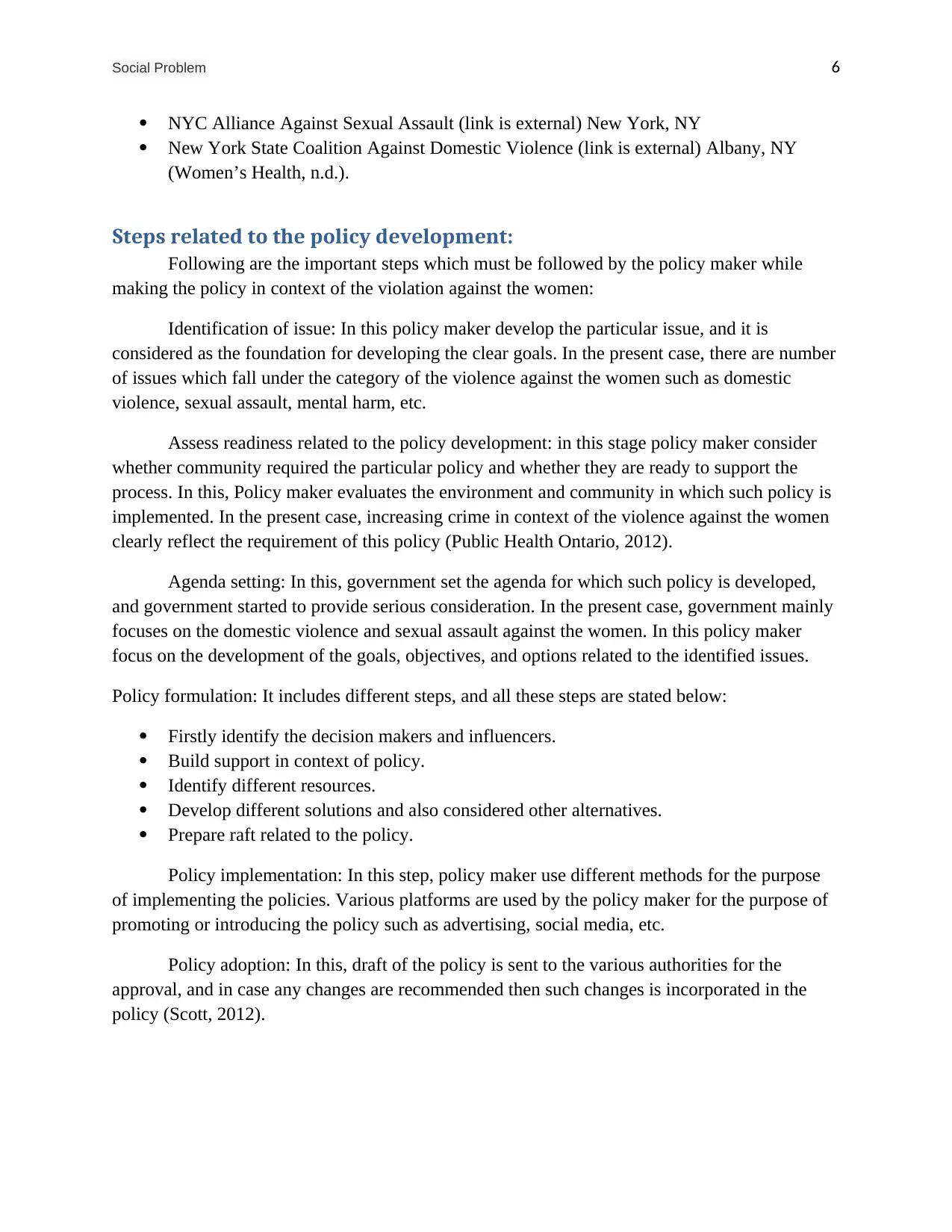
Social Problem 6
NYC Alliance Against Sexual Assault (link is external) New York, NY
New York State Coalition Against Domestic Violence (link is external) Albany, NY
(Women’s Health, n.d.).
Steps related to the policy development:
Following are the important steps which must be followed by the policy maker while
making the policy in context of the violation against the women:
Identification of issue: In this policy maker develop the particular issue, and it is
considered as the foundation for developing the clear goals. In the present case, there are number
of issues which fall under the category of the violence against the women such as domestic
violence, sexual assault, mental harm, etc.
Assess readiness related to the policy development: in this stage policy maker consider
whether community required the particular policy and whether they are ready to support the
process. In this, Policy maker evaluates the environment and community in which such policy is
implemented. In the present case, increasing crime in context of the violence against the women
clearly reflect the requirement of this policy (Public Health Ontario, 2012).
Agenda setting: In this, government set the agenda for which such policy is developed,
and government started to provide serious consideration. In the present case, government mainly
focuses on the domestic violence and sexual assault against the women. In this policy maker
focus on the development of the goals, objectives, and options related to the identified issues.
Policy formulation: It includes different steps, and all these steps are stated below:
Firstly identify the decision makers and influencers.
Build support in context of policy.
Identify different resources.
Develop different solutions and also considered other alternatives.
Prepare raft related to the policy.
Policy implementation: In this step, policy maker use different methods for the purpose
of implementing the policies. Various platforms are used by the policy maker for the purpose of
promoting or introducing the policy such as advertising, social media, etc.
Policy adoption: In this, draft of the policy is sent to the various authorities for the
approval, and in case any changes are recommended then such changes is incorporated in the
policy (Scott, 2012).
NYC Alliance Against Sexual Assault (link is external) New York, NY
New York State Coalition Against Domestic Violence (link is external) Albany, NY
(Women’s Health, n.d.).
Steps related to the policy development:
Following are the important steps which must be followed by the policy maker while
making the policy in context of the violation against the women:
Identification of issue: In this policy maker develop the particular issue, and it is
considered as the foundation for developing the clear goals. In the present case, there are number
of issues which fall under the category of the violence against the women such as domestic
violence, sexual assault, mental harm, etc.
Assess readiness related to the policy development: in this stage policy maker consider
whether community required the particular policy and whether they are ready to support the
process. In this, Policy maker evaluates the environment and community in which such policy is
implemented. In the present case, increasing crime in context of the violence against the women
clearly reflect the requirement of this policy (Public Health Ontario, 2012).
Agenda setting: In this, government set the agenda for which such policy is developed,
and government started to provide serious consideration. In the present case, government mainly
focuses on the domestic violence and sexual assault against the women. In this policy maker
focus on the development of the goals, objectives, and options related to the identified issues.
Policy formulation: It includes different steps, and all these steps are stated below:
Firstly identify the decision makers and influencers.
Build support in context of policy.
Identify different resources.
Develop different solutions and also considered other alternatives.
Prepare raft related to the policy.
Policy implementation: In this step, policy maker use different methods for the purpose
of implementing the policies. Various platforms are used by the policy maker for the purpose of
promoting or introducing the policy such as advertising, social media, etc.
Policy adoption: In this, draft of the policy is sent to the various authorities for the
approval, and in case any changes are recommended then such changes is incorporated in the
policy (Scott, 2012).
⊘ This is a preview!⊘
Do you want full access?
Subscribe today to unlock all pages.

Trusted by 1+ million students worldwide

Social Problem 7
List of Constituents:
Following are the constituents which can be considered by the policy maker for the
purpose off advancing their policy goal:
Political institutions- there are number of institutions which are set up by the government
for the purpose of ensuring women protection in their country such as U.S. department of health
and human services.
Stakeholder’s institutions: there are number of stakeholder’s institutions in the country
which are considered as the representee of the general public such as civil society organizations
and support groups such as women health advocacy groups, etc.
Particular policy action:
Policy action is considered as that action which is designed for the purpose of attaining
the particular purpose by using the power of politics and by conducted activity through political
channels. For the purpose of the present policy, specific policy action is the protection of women
against the domestic violence and intimate partner violence.
Measuring the effectiveness of policy:
It is necessary to develop the criteria for the purpose of measure the effectiveness of the
policy, and for this purpose following criteria is developed:
Monitoring criteria is developed.
Indicators are developed for assessing the planning process in context of implementation
of the policy.
Data is collected and recorded for evaluation process (QP, n.d.).
Conclusion:
After considering the above facts, it is clear that policy ensures the protection of women against
violence such as domestic violence, intimate partner violence, sexual offence, mental harm,
physical harm, etc. Above stated policy is developed after following the defined criteria and it
includes number of steps. This policy is developed after considering the environment in which it
is implemented and also whether community required the particular policy and whether they are
ready to support the process.
List of Constituents:
Following are the constituents which can be considered by the policy maker for the
purpose off advancing their policy goal:
Political institutions- there are number of institutions which are set up by the government
for the purpose of ensuring women protection in their country such as U.S. department of health
and human services.
Stakeholder’s institutions: there are number of stakeholder’s institutions in the country
which are considered as the representee of the general public such as civil society organizations
and support groups such as women health advocacy groups, etc.
Particular policy action:
Policy action is considered as that action which is designed for the purpose of attaining
the particular purpose by using the power of politics and by conducted activity through political
channels. For the purpose of the present policy, specific policy action is the protection of women
against the domestic violence and intimate partner violence.
Measuring the effectiveness of policy:
It is necessary to develop the criteria for the purpose of measure the effectiveness of the
policy, and for this purpose following criteria is developed:
Monitoring criteria is developed.
Indicators are developed for assessing the planning process in context of implementation
of the policy.
Data is collected and recorded for evaluation process (QP, n.d.).
Conclusion:
After considering the above facts, it is clear that policy ensures the protection of women against
violence such as domestic violence, intimate partner violence, sexual offence, mental harm,
physical harm, etc. Above stated policy is developed after following the defined criteria and it
includes number of steps. This policy is developed after considering the environment in which it
is implemented and also whether community required the particular policy and whether they are
ready to support the process.
Paraphrase This Document
Need a fresh take? Get an instant paraphrase of this document with our AI Paraphraser
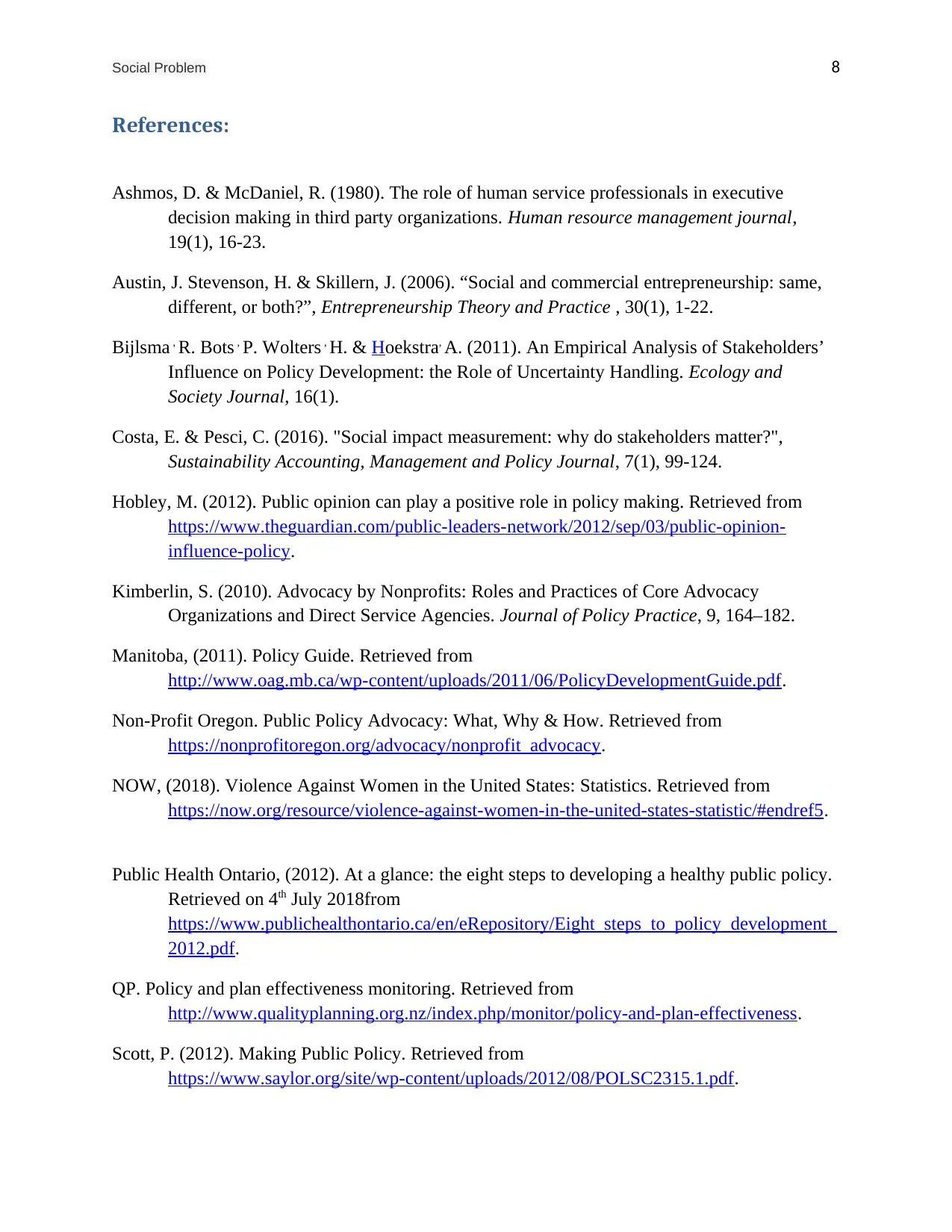
Social Problem 8
References:
Ashmos, D. & McDaniel, R. (1980). The role of human service professionals in executive
decision making in third party organizations. Human resource management journal,
19(1), 16-23.
Austin, J. Stevenson, H. & Skillern, J. (2006). “Social and commercial entrepreneurship: same,
different, or both?”, Entrepreneurship Theory and Practice , 30(1), 1-22.
Bijlsma , R. Bots , P. Wolters , H. & Hoekstra, A. (2011). An Empirical Analysis of Stakeholders’
Influence on Policy Development: the Role of Uncertainty Handling. Ecology and
Society Journal, 16(1).
Costa, E. & Pesci, C. (2016). "Social impact measurement: why do stakeholders matter?",
Sustainability Accounting, Management and Policy Journal, 7(1), 99-124.
Hobley, M. (2012). Public opinion can play a positive role in policy making. Retrieved from
https://www.theguardian.com/public-leaders-network/2012/sep/03/public-opinion-
influence-policy.
Kimberlin, S. (2010). Advocacy by Nonprofits: Roles and Practices of Core Advocacy
Organizations and Direct Service Agencies. Journal of Policy Practice, 9, 164–182.
Manitoba, (2011). Policy Guide. Retrieved from
http://www.oag.mb.ca/wp-content/uploads/2011/06/PolicyDevelopmentGuide.pdf.
Non-Profit Oregon. Public Policy Advocacy: What, Why & How. Retrieved from
https://nonprofitoregon.org/advocacy/nonprofit_advocacy.
NOW, (2018). Violence Against Women in the United States: Statistics. Retrieved from
https://now.org/resource/violence-against-women-in-the-united-states-statistic/#endref5.
Public Health Ontario, (2012). At a glance: the eight steps to developing a healthy public policy.
Retrieved on 4th July 2018from
https://www.publichealthontario.ca/en/eRepository/Eight_steps_to_policy_development_
2012.pdf.
QP. Policy and plan effectiveness monitoring. Retrieved from
http://www.qualityplanning.org.nz/index.php/monitor/policy-and-plan-effectiveness.
Scott, P. (2012). Making Public Policy. Retrieved from
https://www.saylor.org/site/wp-content/uploads/2012/08/POLSC2315.1.pdf.
References:
Ashmos, D. & McDaniel, R. (1980). The role of human service professionals in executive
decision making in third party organizations. Human resource management journal,
19(1), 16-23.
Austin, J. Stevenson, H. & Skillern, J. (2006). “Social and commercial entrepreneurship: same,
different, or both?”, Entrepreneurship Theory and Practice , 30(1), 1-22.
Bijlsma , R. Bots , P. Wolters , H. & Hoekstra, A. (2011). An Empirical Analysis of Stakeholders’
Influence on Policy Development: the Role of Uncertainty Handling. Ecology and
Society Journal, 16(1).
Costa, E. & Pesci, C. (2016). "Social impact measurement: why do stakeholders matter?",
Sustainability Accounting, Management and Policy Journal, 7(1), 99-124.
Hobley, M. (2012). Public opinion can play a positive role in policy making. Retrieved from
https://www.theguardian.com/public-leaders-network/2012/sep/03/public-opinion-
influence-policy.
Kimberlin, S. (2010). Advocacy by Nonprofits: Roles and Practices of Core Advocacy
Organizations and Direct Service Agencies. Journal of Policy Practice, 9, 164–182.
Manitoba, (2011). Policy Guide. Retrieved from
http://www.oag.mb.ca/wp-content/uploads/2011/06/PolicyDevelopmentGuide.pdf.
Non-Profit Oregon. Public Policy Advocacy: What, Why & How. Retrieved from
https://nonprofitoregon.org/advocacy/nonprofit_advocacy.
NOW, (2018). Violence Against Women in the United States: Statistics. Retrieved from
https://now.org/resource/violence-against-women-in-the-united-states-statistic/#endref5.
Public Health Ontario, (2012). At a glance: the eight steps to developing a healthy public policy.
Retrieved on 4th July 2018from
https://www.publichealthontario.ca/en/eRepository/Eight_steps_to_policy_development_
2012.pdf.
QP. Policy and plan effectiveness monitoring. Retrieved from
http://www.qualityplanning.org.nz/index.php/monitor/policy-and-plan-effectiveness.
Scott, P. (2012). Making Public Policy. Retrieved from
https://www.saylor.org/site/wp-content/uploads/2012/08/POLSC2315.1.pdf.

Social Problem 9
The policy Circle. People and places. Retrieved from
http://www.policyproject.com/policycircle/content.cfm?a0=3.
USFA, (2017). The public policy cycle. Retrieved from
https://www.usfa.fema.gov/training/coffee_break/053117.html.
VITAL, (n.d.). Social Service Workers Can Help End Violence against Women. Retrieved from
https://www.intrahealth.org/vital/social-service-workers-can-help-end-violence-against-
women.
WHO, (2017). Violence against women. Retrieved from http://www.who.int/news-room/fact-
sheets/detail/violence-against-women.
Women’s Health.gov, (n.d.). Laws on violence against women. Retrieved from
https://www.womenshealth.gov/relationships-and-safety/get-help/laws-violence-against-
women.
Women’s Health.gov, (n.d.). Resources by state on violence against women. Retrieved from
https://www.womenshealth.gov/relationships-and-safety/get-help/state-resources.
The policy Circle. People and places. Retrieved from
http://www.policyproject.com/policycircle/content.cfm?a0=3.
USFA, (2017). The public policy cycle. Retrieved from
https://www.usfa.fema.gov/training/coffee_break/053117.html.
VITAL, (n.d.). Social Service Workers Can Help End Violence against Women. Retrieved from
https://www.intrahealth.org/vital/social-service-workers-can-help-end-violence-against-
women.
WHO, (2017). Violence against women. Retrieved from http://www.who.int/news-room/fact-
sheets/detail/violence-against-women.
Women’s Health.gov, (n.d.). Laws on violence against women. Retrieved from
https://www.womenshealth.gov/relationships-and-safety/get-help/laws-violence-against-
women.
Women’s Health.gov, (n.d.). Resources by state on violence against women. Retrieved from
https://www.womenshealth.gov/relationships-and-safety/get-help/state-resources.
⊘ This is a preview!⊘
Do you want full access?
Subscribe today to unlock all pages.

Trusted by 1+ million students worldwide
1 out of 9
Related Documents
Your All-in-One AI-Powered Toolkit for Academic Success.
+13062052269
info@desklib.com
Available 24*7 on WhatsApp / Email
![[object Object]](/_next/static/media/star-bottom.7253800d.svg)
Unlock your academic potential
Copyright © 2020–2026 A2Z Services. All Rights Reserved. Developed and managed by ZUCOL.





